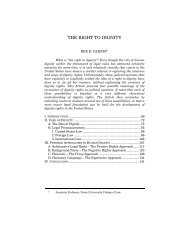A Right to Media? Lorie M. Graham - Columbia Law School
A Right to Media? Lorie M. Graham - Columbia Law School
A Right to Media? Lorie M. Graham - Columbia Law School
Create successful ePaper yourself
Turn your PDF publications into a flip-book with our unique Google optimized e-Paper software.
2010] A RIGHT TO MEDIA? 441<br />
language they speak could disappear within their lifetime and<br />
threaten their very survival as a distinct culture. 40<br />
In response <strong>to</strong> the threat of linguistic extinction and cultural<br />
erosion, many indigenous peoples are now looking <strong>to</strong> the very source<br />
of such threats–the media–as a mechanism of cultural renewal. 41 The<br />
second paragraph of Article 16 speaks directly <strong>to</strong> the role of states in<br />
this endeavor by ensuring that “[s]tate-owned media duly reflect<br />
indigenous cultural diversity.” 42 Moreover, states must “encourage<br />
http://www.unhcr.org/refworld/docid/435cbcd64.html [hereinafter Cultural<br />
Diversity Declaration]; Secretariat, Compilation of General Comments and<br />
General Recommendations Adopted by Human <strong>Right</strong>s Treaty Bodies, at 39–40,<br />
paras. 3.2, 7, U.N. Doc. HRI/GEN/1/Rev.1 (July 29, 1994); United Nations<br />
Convention on the <strong>Right</strong>s of the Child art. 30, opened for signature Nov. 20, 1989,<br />
1577 U.N.T.S. 3, 54 (entered in<strong>to</strong> force Sept. 2, 1990) [hereinafter Children’s<br />
Convention]; International Labour Organization, Indigenous and Tribal Peoples<br />
Convention arts. 28, 30, opened for signature June 27, 1989, 28 I.L.M. 1384<br />
(entered in<strong>to</strong> force Sept. 5, 1991) [hereinafter Indigenous Convention]; UNDRIP,<br />
supra note 20, at 5–6.<br />
40. David Maybury-Lewis, Cultural Survival in the <strong>Media</strong>, Cultural<br />
Survival Q., Summer 1998, available at http://www.culturalsurvival.org/<br />
publications/cultural-survival-quarterly/david/cultural-survival-media.<br />
41. See, e.g., UNESCO, UNESCO and Indigenous Peoples: Partnership <strong>to</strong><br />
Promote Cultural Diversity (2006) (discussing projects supported by UNESCO <strong>to</strong><br />
assist indigenous peoples, including those involving the use of media). Radio is<br />
considered especially effective in terms of transmitting information as it is both<br />
inexpensive relative <strong>to</strong> other forms of media and is more akin <strong>to</strong> the oral<br />
traditions of many indigenous peoples. However, as earlier noted, “interactive<br />
media” is gaining support as a <strong>to</strong>ol of cultural and linguistic renewal and<br />
protection. See generally Crawford & Bray-Crawford, supra note 35, (discussing<br />
the potential for using communications models and technologies for direct<br />
peaceful empowerment of peoples, particularly indigenous peoples).<br />
42. UNDRIP, supra note 20, art.16. Drawing from the recommendation in<br />
the Cobo Report and the three U.N. workshops on media discussed below,<br />
effective measures can be interpreted <strong>to</strong> include such things as financial support<br />
<strong>to</strong> fund the creation and maintenance of indigenous media within existing<br />
systems, the creation of infrastructure necessary <strong>to</strong> receive and impart mass<br />
communication, and the inclusion of indigenous journalists in state-owned media.<br />
See Martinez Cobo June Report, supra note 8, paras. 90–112; Martinez Cobo Sept.<br />
Report, supra note 6, paras. 140–145; see also ESOSOC, Sub-Comm’n on<br />
Prevention of Discrimination & Prot. of Minorities, Working Group on Indigenous<br />
Populations, Report of the Workshop on Indigenous Journalists, U.N. Doc.<br />
E/CN.4/Sub.2/AC.4/1998/6 (Jan. 26–28, 1998) (calling for the financial support<br />
and training of indigenous journalists, for the development of technology <strong>to</strong><br />
support indigenous media, and for the establishment of global and regional<br />
networks linking indigenous journalists with other journalists); ESOSOC,<br />
Comm’n on Human <strong>Right</strong>s, Working Group on Indigenous Populations, Workshop<br />
on indigenous media: “Promoting the rights and cultures of indigenous peoples















